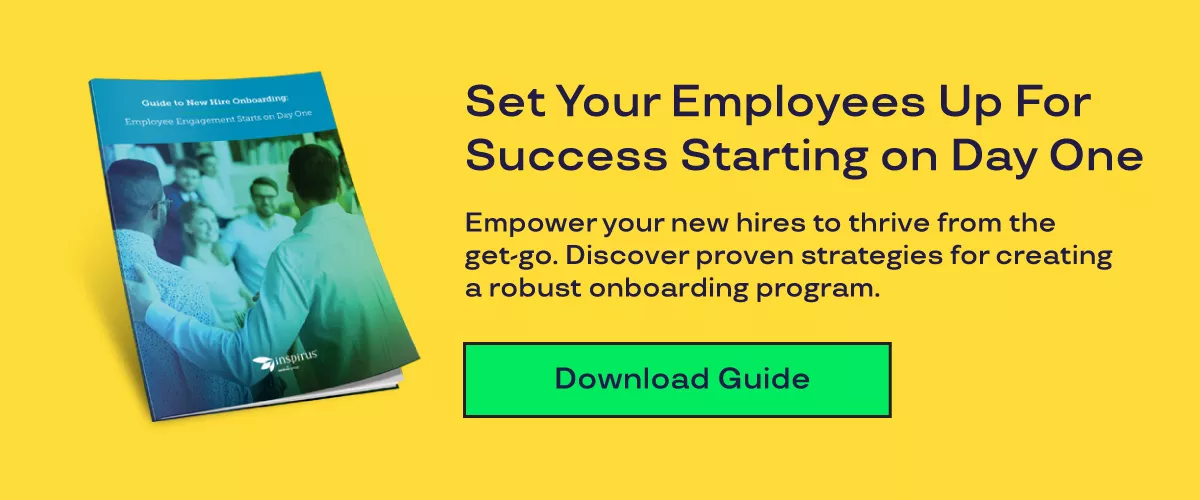
Revolutionizing Onboarding Strategies to Increase Employee Engagement and Productivity
February 9, 2024
Those first few days or weeks on a job are critical for laying the foundation for a long and fruitful relationship.
But, as with many things, the pandemic has forever changed the way organizations think about onboarding. Why? Because we now work in a hybrid world where not all employees are physically on site. That means that employers need to be more creative about how they onboard new employees, while still ensuring that the process serves to introduce employees to the company and culture and pave the way for their success.
Here we take a look at the evolving dynamics of employee onboarding and how companies are rethinking engagement and going beyond traditional approaches to the onboarding process.
The Foundations of Effective Onboarding
Onboarding isn’t the same as orientation, although the two terms are often used interchangeably. To put it simply, the difference between them is that orientation is a one-time event while onboarding is a process. It’s a process that SHRM notes can last for several months. “While orientation is necessary for completing paperwork and other routine tasks, onboarding is a comprehensive process involving management and other employees and can last up to 12 months,” they say.
Orientation, however, can be part of the onboarding process — it’s the part of the onboarding process that deals with administrative details like the paperwork and forms that employees need to complete for both regulatory and company policy purposes.
Successful onboarding, on the other hand, is critical for elevating employee engagement. It’s a process that introduces new employees to the company, its culture, their role, their colleagues, and others who they will interact with during their tenure. The process should be designed to be both interesting and engaging. After all, as they say, “you only get one chance to make a great first impression.” Making a great impression for new employees is important!
It's also important for the onboarding framework to be holistic, meaning that it is all-encompassing and encapsulates the critical elements of working — successfully — at the organization.
Understanding the Nuances of Employee Engagement
Employee engagement is a complex process that goes beyond job satisfaction. Employee engagement refers to the emotional connections that employees feel toward their work, their colleagues, and the company as a whole. It’s a multifaceted concept that serves to connect the employee meaningfully to the organization, boosting the odds that they will stay on board and commit to working towards department and company goals.
Employee engagement can be challenging for companies to define and measure in objective ways. It’s critical that they attempt to do so, though, because engagement is integrally tied to organizational success. And there’s data to prove it!
Gallup research has shown that companies with engaged employees have higher earnings per share. In addition, their meta-analysis of their Q12 survey based on 456 research studies at 276 organizations also established a strong connection between employee engagement and business performance. Harvard Business Review reports that a more tenured, experienced, and full-time customer-facing employee base generated a 50% increase in revenue. And Forbes reports that teams scoring in the top 20% in engagement experience 41% less absenteeism, and 59% less turnover, resulting in an increase of 21% in productivity.
Employee engagement is closely related to both employee satisfaction and retention. Engaged employees tend to have higher job satisfaction, which leads to longer tenure, and a reduction in turnover and its associated costs.
Human-Centric Onboarding for Enhanced Engagement
Despite the surge in hybrid and remote work and an increase in the number of employees who may go through the onboarding process remotely, the human touch is still very important. Companies need to focus on creating a people-centric onboarding process that sets their new hires up for success and enhances engagement. While technology can certainly come into play and can make the process accessible and user-friendly for employees, people working with people is how onboarding leads to the best business results.
One important element of a human-centric approach is designing personalized onboarding experiences. Having a canned approach and using the same process and materials with all employees can be impersonal as well as far less effective in terms of engagement — for both the short and long term. Understanding the needs of individual employees and customizing the experience to meet these needs will provide a more engaging experience and better results.
Empathy also plays a very important role in onboarding. This involves actively listening to the concerns and needs of new employees — as well as their supervisors and managers. Onboarding is a team effort that requires input from many key stakeholders.
In addition to the important role employees’ direct managers and supervisors play, they can also benefit from the support of strong mentors. Leveraging mentorship and support systems for employees, even beyond the formal onboarding experience, can lead to sustained engagement.
Technology and Innovation in Onboarding for Engagement
As we’ve said, while people are a critical element of the onboarding process, technology also has an important role to play. Integrating technology can help to significantly enhance the experience making it more seamless, user-friendly, and accessible for new employees. Technology can offer extensive customization options to make the onboarding process aligned with your organization’s specific workflows, branding, and culture — and with new employee needs.
Emerging technologies like artificial intelligence (AI), virtual reality (VR) and gamification can also enhance engagement and overall satisfaction with the onboarding process. Gamification can improve employee experiences, and keep them more engaged in the process. VR can create emotional connections that impact learning, and can be particularly useful for onboarding remote and hybrid employees in a more realistic way. AI can also be used to help automate tasks, generate documents, track progress, and provide real-time support through chatbots and virtual assistants.
Yes, leverage technology but make sure to include plenty of the human touch as well for an optimal experience and the best results.
Cultivating a Culture of Ongoing Engagement Post-Onboarding
Onboarding, as we’ve seen, is a process — a process that, in truth, is probably never really “over.” Creating a culture of ongoing engagement even after the formal onboarding experience can keep employees continually engaged, interested, enthusiastic, and productive.
While onboarding is designed to integrate new hires into the company, continuous engagement ensures that employees remain connected and motivated beyond their first few weeks or months on the job. Transitioning from onboarding to continuous engagement creates a positive and inclusive work environment where employees feel valued and supported.
Today’s employees increasingly value opportunities for personal development and growth, preferring to stay with companies that provide these opportunities. Supporting this new preference can be a great way to build and maintain engagement throughout an employee’s tenure with your organization.
In addition, along the way don’t overlook the importance of continual feedback and evaluation to help sustain engagement levels — not just from supervisors and managers, but also from senior leaders, peers, and others.
Frequently Asked Questions:
What is the relationship between onboarding and employee engagement?
Onboarding and employee engagement are closely intertwined. Onboarding integrates new employees into the organization and sets the stage for future engagement. Done well, onboarding can lead to a wide range of positive outcomes including increased confidence and higher levels of performance.
How to design onboarding to improve employee engagement?
Designing onboarding to improve employee engagement involves creating a structured and intentional strategy that focuses on long-term engagement and career development. This can be done through the use of tools to track participation and progress, as well as helping new hires establish social connections at work. An effective onboarding strategy should make new employees feel welcome and valued, and provide them with the necessary support to succeed in their current and future roles.
How do you keep employees engaged during onboarding?
Keeping employees engaged during onboarding requires regular check-ins and feedback that goes beyond 30, 60 or 90 days. It’s important to focus on appreciation and recognition for employees’ work and efforts during this time—and throughout their time with the organization. Seeking feedback and input from them about the process—what went well, and what might be improved—will ensure that the next cohort of employees is also highly engaged.
What is recruitment onboarding for employee engagement?
Recruitment onboarding for employee engagement refers to the strategic process of integrating new hires into an organization with a focus on fostering engagement from the outset. This involves ensuring that new employees fully understand their roles, how they relate to the organization's goals, and how and when they will be evaluated. A well-designed onboarding process can have a significantly greater effect on employee engagement and retention, making it an ongoing talent strategy rather than a single event. The goal is to make new hires feel invested in the company and its mission from the start, which can lead to higher retention rates and better performance.
Conclusion
A robust, holistic, and well-designed employee onboarding process can pave the way for employee engagement and, ultimately, overall organizational success. When employees are introduced to your company and their new role in an engaging way, that is both human-centric and fueled by today’s technology, they will feel valued. Effective onboarding ensures that new hires have the tools, resources, knowledge, and new colleague connections to help them feel welcome, valued, and prepared to contribute to organizational goals.
It's important for companies to encourage adaptive strategies for future engagement-centric onboarding designed to meet shifting employee needs and focused on long-term career development. Achieving sustained engagement through holistic onboarding is a continuous process that requires commitment, adaptability, and a focus on individual employee needs—wherever they may be located, whether on site or remote. The time and effort spent will be well worth it as your company drives higher performance through ongoing engagement.
Ready to take your onboarding process to the next level? Download our onboarding guide!





